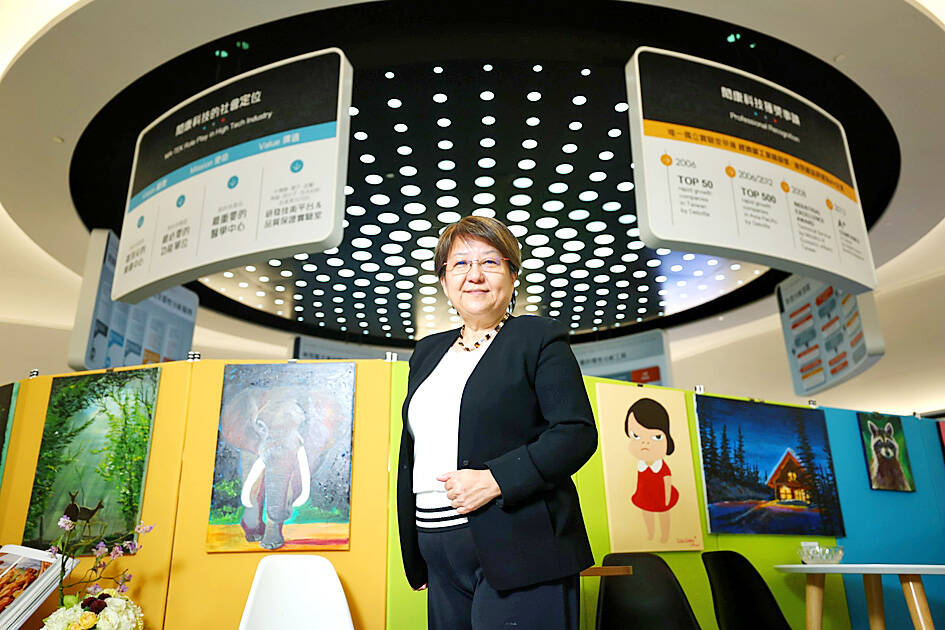Dubbed a “health examiner for IC,” Materials Analysis Technology Inc (MA-tek, 閎康科技) is setting up new laboratories in Kumamoto, Japan, and the US state of Arizona to support its “big clients,” and is eyeing more locations in the future amid the changing IC supply chain landscape.
In an interview with CNA on Saturday, Materials Analysis Technology CEO and chairperson Hsieh Yong-fen (謝詠芬) said the company has benefited from the US-China trade war.
Hsieh said the semiconductor industry has prospered around the world to an extent that would have been hard to imagine five years ago. It has become a national defense industry with governments pushing for their own onshore integrated circuit (IC) production.

Photo: CNA
MA-tek provides analytical services to a wide range of industries, including the semiconductor industry, materials and equipment suppliers, the solar cell industry and optical communications. Clients in the IC industry account for 50 percent of customers, the company’s Web site showed
As many countries are welcoming investment and construction of semiconductor fabs, the prospect for the development of related industries is promising, Hsieh said. MA-tek, which already has 16 laboratories in Taiwan, Japan and China, plans to establish more in the US and Europe, she said.
“MA-tek has been a beneficiary of the US-China trade war,” Hsieh said.
The opening of MA-tek’s lab in Kumamoto last month “was not in [MA-tek’s] original plan,” Hsieh said, though the company did set up a lab in Nagoya, Japan, in 2019 at the invitation of Toyota Motor Corp to work with the latter’s network companies.
The chairwoman said that the Kumamoto lab is for MA-tek’s biggest client, Taiwan Semiconductor Manufacturing Co (TSMC, 台積電), the world’s largest foundry company, which chose the location as its manufacturing base in Japan.
The Kumamoto lab is expected to begin contributing to the company’s revenue in the fourth quarter, Hsieh said, adding that there are plans to build at least two more labs in the city.
As Japan also plans to build semiconductor factories in Hokkaido, the northernmost Japanese prefecture is another possible location for future MA-tek investment, she said.
MA-tek has also already rented premises in Phoenix to be able to provide service to the TSMC fab in Arizona, she said.
Hsieh said that many major TSMC customers in San Jose, California, have also invited MA-tek to build advanced failure analysis labs, and Europe is a “definite destination,” but not in the near future.
In China, MA-tek currently has labs in Shanghai, Xiamen and Shenzhen. While China’s development of advanced semiconductor production processes has currently been blocked, there are still abundant opportunities in automotive electronics, she said, so the company is looking to have labs in other Chinese cities.
Regardless of in which country the company establishes a lab, “MA-tek’s aim is to follow clients and garner the greatest benefits by knowing the clients’ industrial operations well and offering corresponding analysis services,” Hsieh said.
For example, the services provided to a foundry mainly focus on material analysis and surface analysis for the foundry’s advanced semiconductor production processes, and research and development of materials.
On the other hand, when working with IC design companies, failure analysis and reliability analysis are the services most often provided by MA-tek, she said.
Reliability analysis is also most needed in places where there are large end-product markets, such as China, where MA-tek has two such labs in Shanghai, she added.
In terms of the IC industry, Hsieh said as the production process advances, IC structures are becoming more complex, as are measuring techniques.
In the early days, semiconductors were planar, but now both fin field-effect transistor (FinFET) and gate-all-around (GAA) — the two latest state-of-the-art transistor architectures developed to further the performance of ICs — are three-dimensional structures, with GAA being one hundred times more complex than FinFET, she said.
The advancement has made analysis much more challenging, she said, adding that MA-tek has had to introduce artificial intelligence in its programs for measuring and made major investments in outside developers to speed up programming development.
Regarding the company’s prospects, Hsieh said there is still much room for development around the world, as there are potential clients in many industries, including biomedicine, metals and textiles.
For example, in Japan, where cosmetics and beer are objects of MA-tek’s analysis work, “A can of beer does not cost much, but testing costs tens of thousands of yen,” Hsieh said of the beer analysis, in which a Japanese client wanted to analyze the structure of beer foam to understand how it affects the taste.
Impressed by Japanese companies’ approach to research and development, the researcher-turned-CEO lamented that in Taiwan only the top companies are willing to spend on research and development, probably out of pressure to lead and outperform competitors.
Hsieh said she hopes to expand the company’s network as much as possible in overseas markets to avoid cost competition blindly waged by competitors, reaching every science park around the globe in the same ways as McDonald’s Corp and Starbucks Corp.

With an approval rating of just two percent, Peruvian President Dina Boluarte might be the world’s most unpopular leader, according to pollsters. Protests greeted her rise to power 29 months ago, and have marked her entire term — joined by assorted scandals, investigations, controversies and a surge in gang violence. The 63-year-old is the target of a dozen probes, including for her alleged failure to declare gifts of luxury jewels and watches, a scandal inevitably dubbed “Rolexgate.” She is also under the microscope for a two-week undeclared absence for nose surgery — which she insists was medical, not cosmetic — and is

GROWING CONCERN: Some senior Trump administration officials opposed the UAE expansion over fears that another TSMC project could jeopardize its US investment Taiwan Semiconductor Manufacturing Co (TSMC, 台積電) is evaluating building an advanced production facility in the United Arab Emirates (UAE) and has discussed the possibility with officials in US President Donald Trump’s administration, people familiar with the matter said, in a potentially major bet on the Middle East that would only come to fruition with Washington’s approval. The company has had multiple meetings in the past few months with US Special Envoy to the Middle East Steve Witkoff and officials from MGX, an influential investment vehicle overseen by the UAE president’s brother, the people said. The conversations are a continuation of talks that

CAUTIOUS RECOVERY: While the manufacturing sector returned to growth amid the US-China trade truce, firms remain wary as uncertainty clouds the outlook, the CIER said The local manufacturing sector returned to expansion last month, as the official purchasing managers’ index (PMI) rose 2.1 points to 51.0, driven by a temporary easing in US-China trade tensions, the Chung-Hua Institution for Economic Research (CIER, 中華經濟研究院) said yesterday. The PMI gauges the health of the manufacturing industry, with readings above 50 indicating expansion and those below 50 signaling contraction. “Firms are not as pessimistic as they were in April, but they remain far from optimistic,” CIER president Lien Hsien-ming (連賢明) said at a news conference. The full impact of US tariff decisions is unlikely to become clear until later this month

Nintendo Co hopes to match the runaway success of the Switch when its leveled-up new console hits shelves on Thursday, with strong early sales expected despite the gadget’s high price. Featuring a bigger screen and more processing power, the Switch 2 is an upgrade to its predecessor, which has sold 152 million units since launching in 2017 — making it the third-best-selling video game console of all time. However, despite buzz among fans and robust demand for pre-orders, headwinds for Nintendo include uncertainty over US trade tariffs and whether enough people are willing to shell out. The Switch 2 “is priced relatively high”